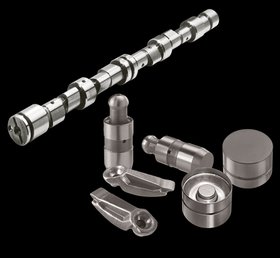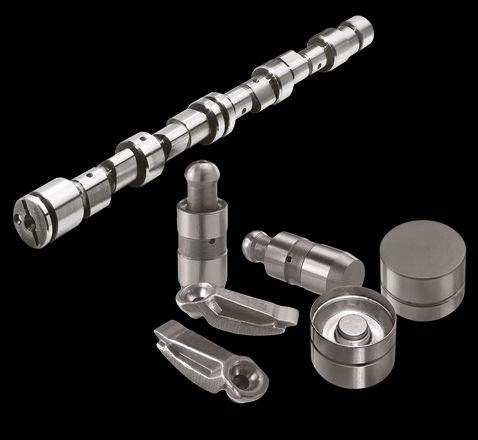Camshaft
The camshaft is a mechanical component of an internal combustion engine. It opens and closes the inlet and exhaust valves of the engine at the right time, with the exact stroke and in a precisely defined sequence.
Function
 The camshaft is a mechanical component of an internal combustion engine. It opens and closes the inlet and exhaust valves of the engine at the right time, with the exact stroke and in a precisely defined sequence. The camshaft is driven by the crankshaft by way of gearwheels, a toothed belt or a timing chain. With a transmission ratio of 2:1, the rate of rotation of the camshaft is half that of the crankshaft.
The camshaft is a mechanical component of an internal combustion engine. It opens and closes the inlet and exhaust valves of the engine at the right time, with the exact stroke and in a precisely defined sequence. The camshaft is driven by the crankshaft by way of gearwheels, a toothed belt or a timing chain. With a transmission ratio of 2:1, the rate of rotation of the camshaft is half that of the crankshaft.
Camshafts are made from the following materials:
- Grey cast iron
- Ductile cast iron
- Heat-treated steel
- Nitrided steel
They can be of hollow design to save weight. Their bearings and the cam tracks are usually surface-hardened. Camshafts are available separately or as a kit. In addition to the camshaft, kits include the corresponding bucket tappets, rockers or rocker arms.
Camshafts in engine block and overhead camshafts
A general distinction is made between camshafts in the engine block and overhead camshafts.
Overhead valves
With overhead valves, the camshaft is located in the engine block and acts on the valves by way of pushrods and rocker arms. This type of valve operation is however only suitable for low-speed engines on account of the numerous mechanical components which have to be moved by the valve spring on closing.
Overhead camshaft and double overhead camshaft
High-speed engines usually have one (OHC) or two (DOHC) overhead camshaft(s) in the cylinder head. They operate the valves by means of rockers, rocker arms or directly by bucket tappets.
Depreciation
To avoid damage caused by worn sliding mating parts, these should always be replaced together with a camshaft.





